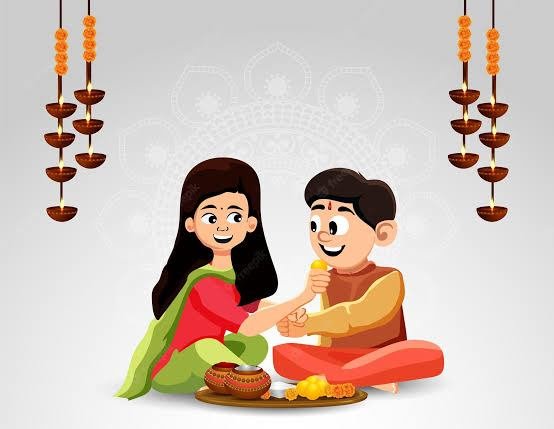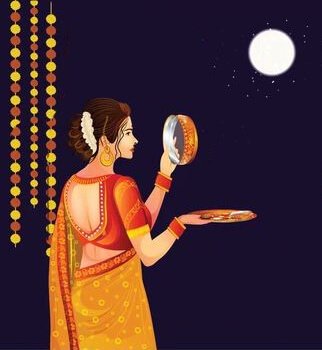By: Priyanka Saurabh
Bhai Dooj or Yama Dwitiya is celebrated two days after Diwali. Sisters take part in the Tika ceremony to pray for the long life of their brothers, while brothers give gifts to their sisters that honour the bond between siblings. Some other names for Bhai Dooj are Bhau Beej, Bhatri Dwitiya, Bhai Dwitiya, or Bhatru Dwitiya. This day is also called Yama Dwitiya, which falls here on Dwitiya Tithi of Kartik month. On Yama Dwitiya, Yama, the god of death, is worshipped along with Chitragupta and Yama-doot, the followers of Lord Yama. Bhai Dooj is a Hindu event. It is composed of two words: “bhai,” meaning “brother,” along with “dooj,” which refers to the second day after the new moon, which is also a day of celebration. This day is especially meaningful in the lives of brothers and sisters. It is a joyous event to honour the deep bond between siblings. Sisters invite their brothers to come to their homes and cook their favourite dishes. Sisters also pray to God for their brothers’ health, quality of life, and protection from all diseases and misfortunes. In return, brothers fulfill their obligations to care for and worship their sisters.
Bhai Dooj is an important festival that is celebrated all over India with great zeal and enthusiasm. The ceremony begins with inviting the brothers to a sumptuous feast of their favourite food or sweets. The whole incident represents a brother’s promise to protect his sister, while a sister prays to God and wishes for her brother’s well-being. Traditionally to end the rites, sisters make a seat for their brothers out of rice flour. Here on the forehead of the brother, a sacred tika made of vermilion, along with curd, rice is applied. After that, the sister places pumpkin flowers, paan, betel nut, or cash in the palms of her brother and slowly chants the shlokas while pouring water. After that, she also performs aarti. The lamp facing south is lit and seeing a kite flying in the sky is a good omen for the fulfillment of wishes. While savouring the feasts, the brothers are given their favourite sweets and water to drink. In the program, Bhai Dooj gifts are exchanged between brothers and sisters, and blessings of elders are sought.
According to Hindu scriptures, Goddess Yamuna was very close to her brother Lord Yama, who was the god of death. She had a strong desire to see her brother as they had not seen each other for a long time. When Lord Yama arrived two days after Diwali to greet his sister, Goddess Yamuna, overwhelmed with emotion, placed a tikka on her forehead while cooking a delicious meal for her. Lord Yama was impressed by his sister’s act and instructed her to ask for a boon. Goddess Yamuna laughingly invited him to come to her once a year, saying that one whose sister would put tilak on her forehead would not be afraid of her brother Lord Yama because her sister’s love would protect her. Lord Yama fulfilled this favor and the festival of Bhai Dooj, which has become a tradition of Hinduism and an important component of the five-day Diwali celebrations. Bhai Dooj is a festival that honours the love, bonding, and togetherness of brother and sister. This event is similar to Raksha Bandhan and has the same goal. On this day sweets or gifts are exchanged between brothers and sisters. As a symbol of their devotion and to protect their brothers, sisters put tikka on the forehead of their brothers.
Bhai Dooj is a national holiday celebrated all over India. However, it is known by different names in different country classes. In Maharashtra and Goa, it is considered as ‘Bhau Beej’, but in Bihar and Uttar Pradesh, it is considered as ‘Bhau Tika’. It is called ‘Bhai Phota’ in West Bengal. In Nepal, this dish is known as ‘Bhai Tihar’. Every woman in our country celebrates Bhai Dooj to show her support and compassion for her brother. On this day all sisters pray to God for the happiness of their brother’s life. It is widely believed because the Yamuna got a promise from her brother Yamraj that only by celebrating Bhai Dooj one can get rid of Yamraj’s fear and even increase the love or feeling between brother and sister. In return, brothers give a lot of happiness to their sisters with gifts. Like Raksha bandhan, Bhai Dooj strengthens the bond between brother and sister.
Tying a rakhi represents a brother’s commitment to protect and protect his sister from evil forces. By applying a tika on her brother’s forehead during Bhai Dooj, the sister promises to protect her brother by all means. Sisters perform aarti for their brother and then apply a red tika on his forehead. Bhai Dooj is compared to the Indian festival of Raksha Bandhan, in that it commemorates the enduring relationship between a brother and a sister. In this special event, brothers visit their sisters to check that they are well and distribute gifts or sweets. (The author is a Research Scholar in Political Science, poet, freelance journalist, and columnist)







